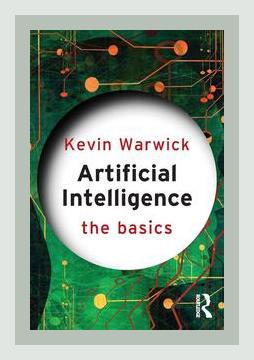Technology and Digital TransformationArtificial Intelligence
Introduction
“Artificial Intelligence: The Basics” written by Kevin Warwick in 2011 provides an accessible overview of the complex and rapidly developing field of artificial intelligence (AI). Warwick, a professor of cybernetics with a focus on human-robot interaction, explores the theoretical foundations, practical applications, and ethical implications of AI. The book is structured to engage readers without a technical background while offering essential insights into how AI technologies are reshaping industries and everyday life.
1. Understanding Artificial Intelligence
Major Point:
AI is the simulation of human intelligence processes by machines, particularly computer systems. These processes include learning, reasoning, and self-correction. Warwick distinguishes between “weak” AI, which is designed for narrow tasks, and “strong” AI, which aims for general intelligence comparable to human cognition.
Specific Action:
To better understand AI, a person can start by exploring simple AI applications such as chatbots or virtual assistants like Siri or Alexa. Analyzing how these systems respond to queries reveals their reliance on pre-programmed algorithms and machine learning.
Example:
Warwick describes IBM’s Watson, which gained fame for winning the game show Jeopardy. Watson’s ability to process natural language and retrieve information accurately demonstrates the capabilities of weak AI in parsing complex queries and presenting meaningful data.
2. History and Evolution of AI
Major Point:
The evolution of AI has been marked by significant milestones, from Alan Turing’s pioneering work on algorithms and computation to the development of expert systems in the 1980s. Each advancement brought AI closer to replicating human cognitive functions.
Specific Action:
A person can delve into historical AI projects and research papers to understand the progression of AI technologies. Learning from past successes and failures can provide valuable context for current AI developments.
Example:
Warwick highlights the Turing Test devised by Alan Turing, where a machine’s ability to exhibit intelligent behavior indistinguishable from a human is evaluated. Engaging with historical AI platforms that attempted the Turing Test can illustrate the challenges and breakthroughs in human-machine communication.
3. Machine Learning and Neural Networks
Major Point:
Machine learning, a subset of AI, enables systems to learn from data and improve over time without explicit programming. Neural networks, inspired by the human brain’s architecture, are critical in advancing machine learning.
Specific Action:
Individuals interested in AI can start by experimenting with machine learning algorithms using platforms like TensorFlow or PyTorch. Online courses and tutorials can provide hands-on experience in training models and analyzing their performance.
Example:
Warwick describes the use of neural networks in image recognition, where a model is trained on vast datasets to identify patterns and classify images accurately. Tools like Google’s DeepDream, which enhances patterns in images, offer a playful yet educational way to see neural networks in action.
4. Robotics and Autonomous Systems
Major Point:
Robotics is a significant application area for AI, where autonomous systems are designed to perform tasks ranging from mundane household chores to complex industrial operations. The combination of AI algorithms and physical robots illustrates the potential for intelligent machines in various environments.
Specific Action:
Engaging with robotics kits like LEGO Mindstorms or Arduino can introduce foundational concepts in robotics and AI integration. Building and programming simple robots can provide practical insight into autonomous system design.
Example:
Warwick discusses his own experiments with robotics, including a project where a robot arm controlled directly by his neural signals demonstrated the capacity for brain-machine interfaces. Participating in DIY projects or competitions like FIRST Robotics can further understanding and innovation in this field.
5. Natural Language Processing (NLP)
Major Point:
NLP is a branch of AI focused on the interaction between computers and humans through natural language. It involves enabling machines to understand, interpret, and generate human language.
Specific Action:
A practical step to explore NLP is to use tools like Natural Language Toolkit (NLTK) in Python. Writing simple scripts to analyze text data can showcase how NLP techniques are employed to extract meaningful insights.
Example:
Warwick cites Google Translate as an example of NLP, where complex models analyze bilingual text data to provide accurate translations. Experimenting with online translation services and comparing their outputs can help identify how NLP models overcome linguistic challenges.
6. Ethical and Societal Implications
Major Point:
The rise of AI presents ethical dilemmas and societal challenges, including job displacement, privacy concerns, and decision-making biases in AI systems. Ensuring ethical AI development requires balancing innovation with responsibility.
Specific Action:
A person can advocate for ethical AI by participating in discussions and policy-making processes. Joining organizations like the IEEE Global Initiative for Ethical Considerations in AI can offer platforms to influence AI development norms.
Example:
Warwick discusses the potential misuse of AI in surveillance and military applications. Raising awareness about ethical AI usage through community outreach and educational programs can lead to more informed public discourse.
7. Future Prospects of AI
Major Point:
The future of AI is both exciting and uncertain, with potential advancements such as superintelligent AI challenging our understanding of technology and its impact on human life.
Specific Action:
Staying updated with AI research by following journals, attending conferences, and participating in AI forums can help individuals remain informed about cutting-edge developments and their implications.
Example:
Warwick speculates about the eventuality of AI surpassing human intelligence, often referred to as the “singularity.” Engaging with speculative fiction and futurist literature can stimulate critical thinking about plausible AI futures.
Conclusion
“Artificial Intelligence: The Basics” by Kevin Warwick offers a comprehensive yet accessible exploration of the AI landscape. By grounding complex ideas in practical examples and ethical considerations, the book equips readers with the knowledge to understand and engage with AI technologies thoughtfully. Whether experimenting with AI tools, advocating for ethical standards, or staying informed about future trends, there are numerous ways individuals can apply the insights provided by Warwick to navigate the evolving field of AI.
Technology and Digital TransformationArtificial Intelligence
